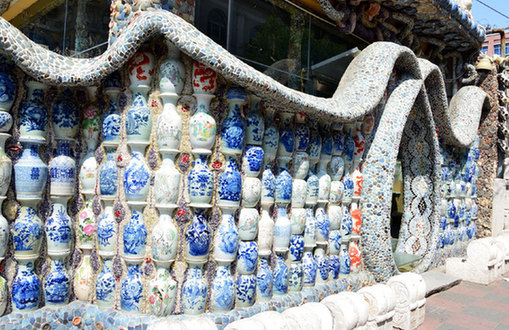China House in Tianjin
 0 Comment(s)
0 Comment(s) Print
Print E-mail CRI, September 18, 2014
E-mail CRI, September 18, 2014
China House in Tianjin [Photo:CRIENGLISH.com]
Located on Chifeng Street, China House is originally a French style villa and now renovated by its present owner Zhang Lianzhi as a unique porcelain museum which are all covered with porcelain pieces. Having taken 4 years to complete, this original China House is of great antique flavors and no doubt the most characteristic and eye-catching building in the city attracting visitors from home and abroad. According to Zhang, the inspiration comes from a wall covered with ancient ceramic chips in his first private museum also in Tianjin City, the Huayun Museum.
Covering an area of nearly 4000 square meters, China House is decorated with over 400 million pieces of ancient Chinese ceramic chips, more than 5000 ancient porcelain vases, 4000 porcelain plates and bowls, as well as over 400 white marble carvings, 20 tons of natural crystals and agates, and over 300 stone lions in diverse sizes of different times. All the ceramic chips collected of dynasties of Song, Yuan, Ming and Qing are pasted on every space of the grand building make it gleaming under the sunshine. The courtyard wall is covered with around 3,000 porcelain vases, and is called "Ping'an Qiang" (Peaceful Wall or Wall of Wellness)for a propitious meaning, as the Chinese character " peace" shares the same pronunciation "ping" with "vase" .
Outside the door, there is a pair of stone lions made in the Ming dynasty. They are nearly 1 meter high with delicate manual work. Perhaps the most impressive are the Loong and Phoenix entwining the exterior wall of the house, which symbolize the power of ancient China and are one of the most dominant features in Chinese architecture.
Inside the house, many luxurious antiques are kept. A basso-relievo of a 768-meter-long dragon is flying on the top of the Porcelain House consisting of hundreds of thousands of ceramic chips surrounded by porcelain auspicious clouds with an obvious mark "china". What is more interesting and ingenious is that, on the walls of each floor, are exhibited numerous celebrated calligraphies and paintings of all ages both domestic and foreign, collaged also by ancient ceramic chips. Those paintings include one of the most classical and famous picture of Tang Dynasty, named Five-Bull Chart.






Go to Forum >>0 Comment(s)